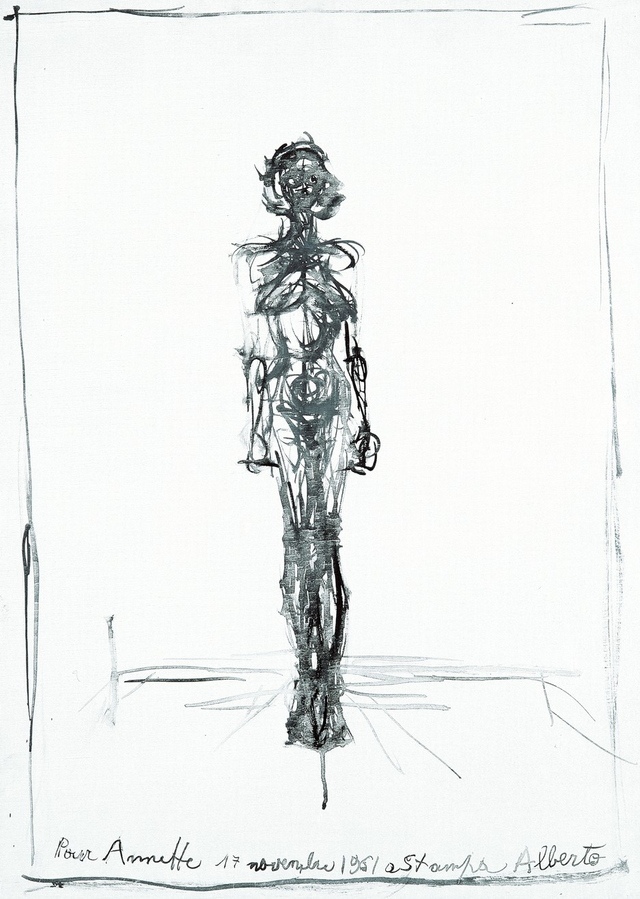Alberto Giacometti
Alberto Giacometti was one of the most important sculptors of the 20th century whose creative output also extended to painting and drawing.
Biography of Alberto Giacometti
Alberto Giacometti was born in 1901 in Borgonovo, Switzerland, near the Italian-Swiss border. His father, Giovanni, was an accomplished Post-Impressionist painter, and his godfather and uncle were also artists, which played a crucial role in his early artistic education. The family relocated to Stampa in 1906, where Giacometti's passion for drawing began to manifest. In his teens, he started painting, sculpting, and creating wood etchings, experiencing early success.
Giacometti moved to Geneva in 1919 to pursue an art career, studying at the École des Beaux-Arts and École des Arts et Métiers. In 1920, he attended the Venice Biennale with his father, and in 1921, he explored Rome, Florence, and nearby areas. During this period, Giacometti developed a keen interest in Egyptian and African art.
In 1922, the artist moved to Paris to study under the sculptor Antoine Bourdelle, an associate of the renowned Auguste Rodin. Over the next four years, he honed his sculpture skills at the Académie de la Grande-Chaumière. Alberto explored Cubism and Surrealism, quickly establishing himself as a leading surrealist sculptor. He collaborated with influential artists such as Joan Miró, Max Ernst, Pablo Picasso, Bror Hjorth, and Balthus.
During this period, Giacometti nurtured his passion for primitive art, leading to increasingly abstract representations of the human body in his work. By the time of his graduation, he had completely forsaken realism, focusing on conveying the psychological essence of his subjects. Notable works from this period include the renowned "Spoon Woman" and "The Couple."
In the early 1930s, Giacometti's distinctive and uncompromising artistic style garnered the admiration of key figures within the Surrealist movement, including André Breton, Man Ray, and Georges Bataille. Their significant influence on his work is evident in dreamlike and metaphorical pieces like "Suspended Ball" (1931), "Walking Woman I" (1932), and "The Palace at 4 a.m." (1932). Nevertheless, his exploration of the nature of existence eventually led Alberto to move away from Surrealism.
In the latter half of the 1930s, Giacometti directed his creative energies toward a series of head sculptures, aiming to capture his own physical relationship with his models in space. Unfortunately, at the peak of his creative endeavors, the outbreak of World War II and the German army's advance into France compelled the artist to flee Paris and return to Switzerland. During this period, his sculptures took on a slender and increasingly small size, imparting the figures with a sense of solitude and suffering.
Upon returning to Paris after the war's end, Giacometti discovered that his earlier works and the existentialist philosophies they embodied had gained significant popularity in the French capital. His new creations resonated deeply with the prevailing postwar sentiments of despair and loneliness. He became highly sought after by museums and collectors alike, leading to solo exhibitions in New York City in 1948 and 1950. His art came to symbolize the profound toll exacted by the German atrocities on all of Europe, and the artist was often described as existing perpetually on the precipice between nothingness and being. Throughout the 1950s, Giacometti's art continued to evolve, with his sculptures growing larger, thinner, and more complicated design.
Additionally, he embarked on a series of portraits featuring family members like his wife, Annette, whom he married in 1949, and his brother, Diego. He also portrayed some of his well-known friends, including Jean Genet, Henri Matisse, and Igor Stravinsky.
By 1965, Alberto Giacometti had achieved international fame and entered a mature phase in his life and career. During this period, he engaged in an extended series of illustrated works for books by contemporary authors like Paul Eluard and revered literary figures from the past, including Cervantes and Balzac. He received a commission from Samuel Beckett to create a tree sculpture for a production of "Waiting for Godot." In 1962, he was honored with the Grand Prize for Sculpture at the Venice Biennale. This achievement held special significance for him, as he had admired the Venice Biennale since his father had taken him to the festival in his youth.
Two years later, he was awarded the Guggenheim International Award for Painting, followed by retrospectives of his work at the Tate Gallery in London and the Museum of Modern Art in New York. Regrettably, by then, Giacometti's health had significantly deteriorated, and he passed away in 1966 in Chur, Switzerland.
Alberto Giacometti's Art Style
Alberto Giacometti forged his distinctive aesthetic style by drawing from the conceptual foundations of Surrealism and Cubism. His artistic signature emerged throughout delicate figurative sculptures and expressive portraits that resulted from meticulous observations.
During his entire professional career, the artist was particularly captivated by the writings of Jean-Paul Sartre. Influenced by the ideas of Existentialism, he sought to break decisively with the sculptural traditions that, in his view, were stifling the medium.
His artistic oeuvre forms a unique amalgamation of ideas rooted in primitive art, psychoanalytic theory, and children's art. Giacometti's austere figures delve into the depths of the human psyche, energizing the space inhabited by an individual. Many experts and art critics suggest that Alberto Giacometti's works can be interpreted as metaphors for the postwar experience of uncertainty and alienation.
Years:
Born in 1901
Country:
Switzerland, Borgonovo
Gallery:
Galerie Thomas
Luxembourg + Co.
ACQUAVELLA
Landau Fine Art
Helly Nahmad Gallery
Galerie Knoell
Vedovi Gallery
Mennour
Gagosian
Peter Freeman, Inc.

